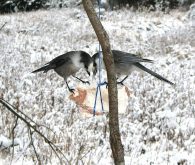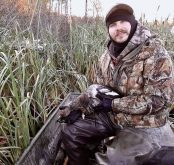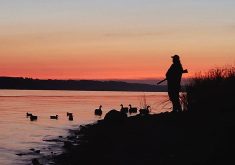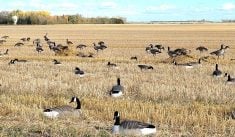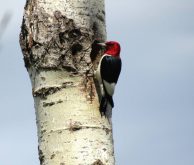One of my valued outdoors mentors summed up deer hunting perfectly: “It’s lousy, until it’s good, and then it’s over.”
Actually, he used a stronger word than lousy, but this is a family audience.
Like me, he favoured hunting from a blind, waiting for the deer to come to the hunter. Depending on where you hunt, or how particular you are about the animal you may take, the wait often runs into days. Over time, you are slowly absorbed into the surroundings and the blind becomes a window into nature. Wild critters either don’t know you’re there or simply adjust to your presence.
Read Also

Electric fence to keep mice out of combines
Rodent Shield Systems reduces off-season damage in stored combines from mice and rats via an electric fence.
It would be a big fib to say that interesting stuff is always happening. In fact, there are very long periods where nothing seems to happen except the passage of time. But every now and then, something happens that gives special meaning to all that sitting around.
[RELATED] More with Tim Sopuck: The greatest fishing spot in Manitoba
Cherished memories
This year I spent four days in the muzzleloader season on a stand in the wild woods of Whiteshell Provincial Park. I have used the same remote blinds along Moose Creek (our family name; don’t bother looking for it on a map) for 15 years, and I have spent the better part of 80 days out there watching and waiting for something to happen.
I feel like I am walking into my den when I nestle in at dawn. This year’s Moose Creek deer report is easily summarized: I had one fleeting glimpse of a doe and fawn.
After the hunt I checked my trail camera, which had three recent wolf pictures. The second one looked like a chase scene, with running deer in the first picture and a trotting wolf a minute later. Fresh tracks along the nearby creek suggested the wolf was focused on hunting beavers, their main food source during open water.
With all that predator traffic, perhaps the area was too hot for deer. Or perhaps the weather was too warm and the deer weren’t moving, or they slipped by when I had nodded off. We deer hunters are practiced at rationalizing failure.

Make no mistake, I am there to put venison in the freezer. However, if the hunt were just about the meat, I would choose a far easier hunt than Moose Creek, which requires a boat trip, a walk in the forest and, often, long hours of hunting.
I hunt there because it’s wild, it’s pretty, there is an amazing diversity of wildlife and there are cherished memories tied to this place. Some unusual wildlife encounters are burned into my brain.
Birds aplenty
This year, birds were especially abundant, and the highlight was a great grey owl on the hunt for voles. I had noticed a few voles scurrying around the forest floor, and the thought came to mind that it would be a good winter for great greys, given their focus on this prey.
As luck would have it, a lone owl landed on a high perch overlooking the ash forest I was watching. After a few minutes of scanning the terrain, it flew on a little way to survey from a new perch. I watched this repeated three times before it flew out of sight. Its silent flight through the quiet landscape reinforced the serenity of my surroundings.
[RELATED] Help keep count at your bird feeder
I saw and heard woodpeckers every day, but the real treat was a pileated woodpecker that set up for a little grub-mining in a dead tree about 15 yards away. About the size of a crow, they are among our most striking resident birds. Its loud, primeval call embodies the mood of the late autumn boreal landscape.
I also saw pine grosbeaks, chickadees, nuthatches, jays, crows, ravens, eagles, ruffed grouse, a brown creeper and the ever-present gray jay, also known as whiskey jacks.
The whiskey jacks at Moose Creek are a special part of my hunt. It’s contrived, in that I attract them with some suet that I hang near the blind. This habit started almost 20 years ago, when my son, Mark, was deer hunting with me for the first time.
After paying his dues on stand for three days, a three-year-old buck stepped into the opening we were watching and, soon after, we were celebrating his first deer.
Elation soon gives way to the work at hand. As we field dressed the animal, I was quickly reminded that what was unusable waste to us was a scavenger’s bounty for the whiskey jacks that had found us.
As we opened the animal and released a steaming mass, the whiskey jacks were working amongst us to snatch bits of fat and protein, which they would cache nearby for the long winter ahead.
Work completed, we hauled the carcass back to the blind and simply enjoyed our surroundings, especially the foraging, quarrelling whiskey jacks. After a few minutes, I went back to the viscera, cut away some suet pieces, and hung them from our blind.
The brash birds were soon sitting on our gun barrels, waiting to get at the best pickings, not to mention snatched bits of salami out of the sandwiches that were offered at arm’s length.
I soon got in the habit of bringing some deer backfat on every hunt. The birds, usually a family group of three, find me by sunrise and work the food all day. They take a mouthful, fly off to cache it, and come back right away to do it all over again.

They must associate me, my blind and this time of year with an abundance of food because, they unfailingly find me on the first day. This even happened after I had skipped two years hunting there because of low deer numbers.
A critter that relies on food caches scattered through its territory has to have a good long-term memory. With these birds, it seems to last a year or more.
Foraging and caching all day, the birds are a welcome background presence that also gives me a peek into whiskey jack society. I think I have deciphered their mix of quiet whistles and chatters, which seem to hold the group together and maintain a pecking order. I also know that when they issue a harsh rattle, some threat is afoot, like a hawk or ground predator.
I have also learned that they have a special fondness for bagels. Well, probably not just bagels, but bread products in general. At lunch time I will hold out my bagel and soon they are sitting on the blind rail, deciding if the orange-clad beast is harmless enough to cadge a novel meal. Before long the bagel gets mobbed, and my hand becomes a convenient perch. The part of me that hasn’t really grown up never tires of this little exchange.
Large predators
This year, the howl of a lone wolf in the distance reminded me of the time Mark and I felt like we were part of the pack. That morning we had split up, with Mark in a blind about 300 yards up the creek from me. Shortly after sunrise, the boreal solitude was ripped by a group of about four wolves, howling furiously.
What made it really interesting was that they were perhaps 200 yards upstream of Mark. They were joined by at least three more that lit up from the opposite quarter, just downstream of me. Like Mark, I couldn’t see them but, man, were they close!
After what seemed like an eternity – it was probably less than a minute – the forest went eerily quiet. Over the next 20 minutes or so we saw three deer and one wolf flash across the creek.
I figure the wolves were working the area and they stumbled upon us. Later, I asked my young teenager if he felt like we had become the hunted, if even for a fleeting moment. He said, “No … well, maybe a little.”
Another wild woods predator made an interesting appearance a few years later. I had field dressed a young buck I had taken, and had made the walk out to my boat to stow my gear before returning to haul it out. In that short span, a pine martin, which normally terrorizes red squirrels, had found the gut pile and was busily carving off and caching the best hunks in some nearby deadfall.
As I set up the dragging harness, this usually shy member of the mink family was coming within a few feet of me to haul away yet more goodies.
After marveling at this chance encounter with one of our prettiest mammals, I got on with my task, hauling my bounty to the boat. During one of my many stops to catch my breath, I heard some rustling from behind and saw the martin approaching.
I was astounded when it came right up to me and tried to tear chunks out of the butt end of the carcass. I actually had to shoo it away. In retrospect, the sacrifice of a rump roast would have been well worth having this close encounter carry on longer.
All hunts come to an end, but the memories last. My encounters with wild critters may not be National Geographic TV grade, but they are special to me and the prospect keeps me coming back to the blind, ever hopeful that Mother Nature will reveal a little more.




